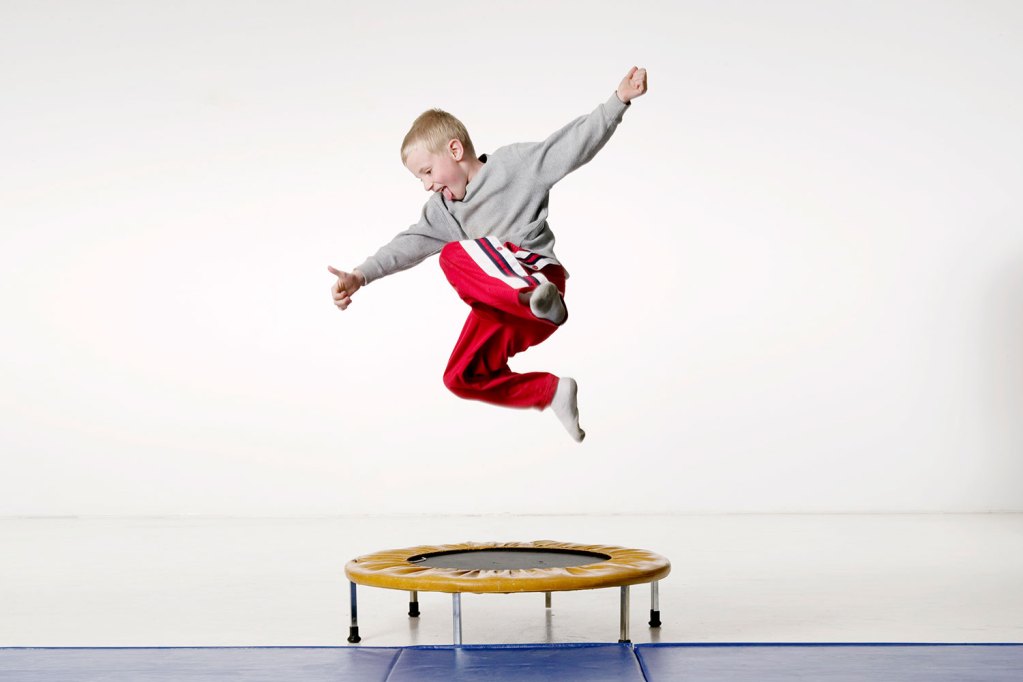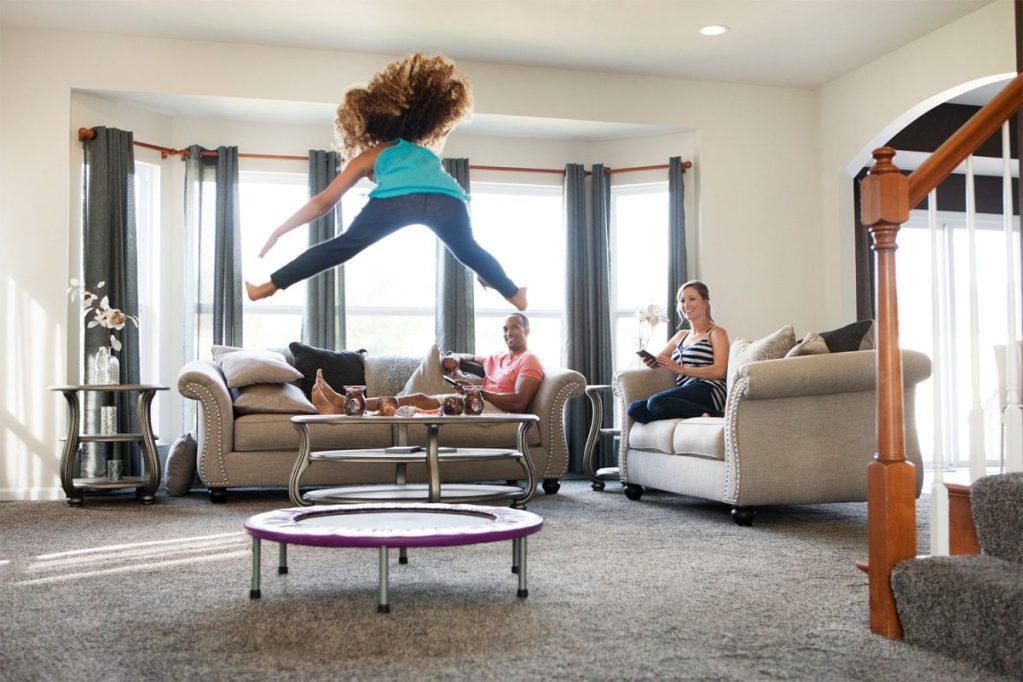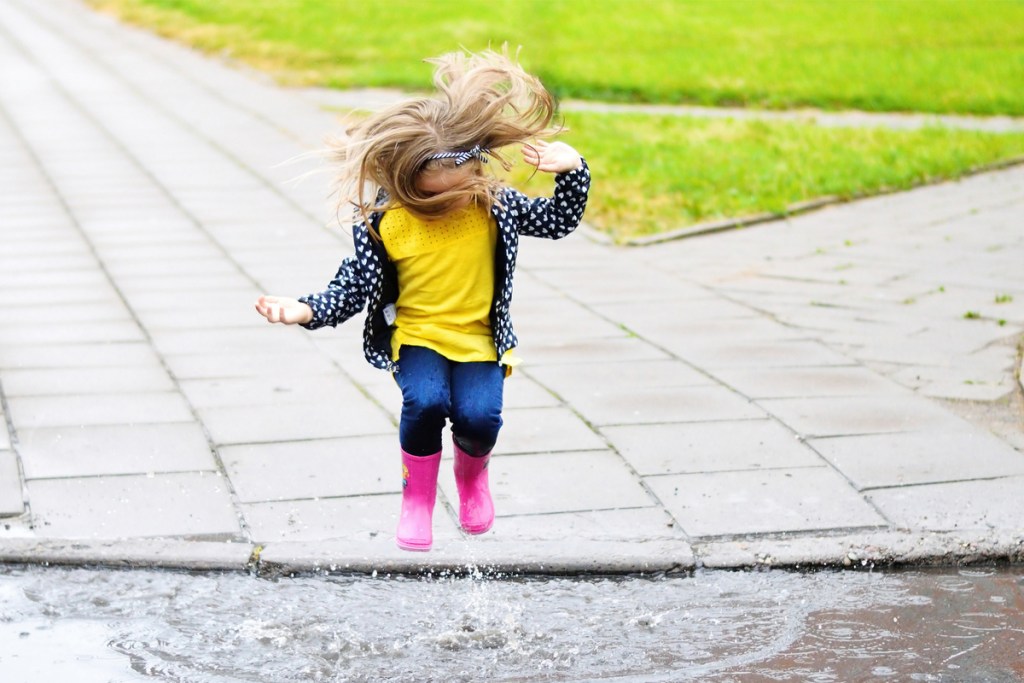
Kids certainly love to jump. Most of us have fond memories of jumping on the family trampoline or heading over to a friend’s house to jump. Along with the good though comes the bad. Maybe you had a broken wrist from a spill off of a trampoline or perhaps a sibling split a lip. Sure, trampolines are a fun part of childhood, but it’s different now that you’re a parent.
Trampolines have come a long way since their beginnings. Those backyard trampolines are just one of the trampolines your kiddos can get jumping on. Today, there are indoor trampolines you can have in your own home.
While trampolines may have their perks and get the kiddos up off of the couch, are indoor trampolines safe? Anything can be dangerous with misuse, but could an indoor trampoline actually be an accident waiting to happen rather than the exciting activity you remember fondly? Let’s take a look at the pros and cons to help you decide if an indoor trampoline is right for your household.

Are indoor trampolines safe?
While you may have cool memories of jumping on a trampoline in the backyard or at a trampoline park, the fact of the matter is trampolines account for a significant amount of emergency room visits every year. According to the American Academy of Orthopedic Surgeons, over 300,000 trampoline-related injuries were treated in 2018. That number included more than 100,000 visits to an ER. Typical trampoline injuries include arm and leg sprains and breaks. While those types of injuries heal well, especially in the kiddos, trampoline accidents can also cause more serious head and neck injuries. Of course, trampolines aren’t all doom and gloom. They have quite a few perks especially when the raindrops or cold weather keep energy-packed kids from heading outside.
Benefits of indoor trampolines
Trampolines are a good exercise for children, especially if you don’t have access to an outdoor yard. Jumping on a indoor trampoline helps release energy and frustration while keeping the heart rate up. It’s a terrific cardiovascular exercise, and there’s a reason trampolines are used in fitness classes.
Trampolines are also great for children’s perception and gross motor skills. Jumping targets the vestibular nervous system. The vestibular nervous system provides information to the brain about position and spatial awareness.
As children jump, they learn to feel where their body is with a rapidly changing surface. It requires them to coordinate their core, muscles, and feet in a way that contributes to overall balance and coordination.
Jumping may also be beneficial for focus. Some studies show that the act of jumping helps the brain to relax because of the physical activity. Jumping doesn’t tax the body in the same way running or jogging would though which means it’s better on the joint.
Overall, jumping on an indoor trampoline is a low-impact exercise with a lot of physical benefits for kids as far as practicing coordination, heart health, and focus. Mini trampolines give children the chance to reap the benefits without requiring a lot of space.
Downsides of indoor trampolines
With the fun comes significant downsides to indoor trampolines, especially if your child is under the age of six. The American Academy of Pediatrics recommends that children should never have a trampoline if they are kindergarten age or younger because the risk of injury is high.
While most of these recommendations are actually for outdoor trampolines, an indoor trampoline can be just as dangerous. Young children don’t have the coordination or ability to manage a trampoline, and this can cause them to flip over or fall off when bouncing vigorously.
Indoor trampolines can sometimes come with an attached handle, giving children something to hold on to while they jump. This is an improvement over a standard indoor trampoline, but children can still damage their teeth or misuse the trampolines without proper supervision.
Many organizations are worried about the lack of proper data to help parents make the right decision. Trampoline statistics tell parents only part of the injury picture, and even fewer statistics exist for indoor trampolines.
Trampoline risk is hard to measure
The biggest problem with indoor trampolines is that we can’t measure the risk adequately. We can find out how many children visited the hospital due to a trampoline accident last year, but we don’t know how many children had access to trampolines, how long they jumped, or if the injured children were being supervised.
Many of the statistics for trampolines are tied to large outdoor trampolines, where children are more likely to jump with groups of kids at the same time. Injuries from falls or crashing into each other are some of the most common, along with doing dangerous tricks.
Indoor trampolines may pose less of a risk because they’re designed for only one jumper, and they’re much closer to the ground. There is also limited space to do significant tricks. The same dangers though could still be an issue because indoor trampolines are more accessible. They’re in your living room or your child’s room, ready to play at any time of the day. Parents may be less likely to supervise vigilantly because they perceive the risk to be minimized since it’s an indoor trampoline.

Keeping indoor trampolines safe
Childhood is not without risks. Injuries are going to happen as kids explore and play. Unfortunately, bubble wrapping them is not an option. When it comes to an indoor trampoline, your child can get some physical and mental benefits, but the best policy is to proceed with caution. If you decide to bring an indoor trampoline into your home, consider a few rules first.
Limit exposure
Instead of putting it in your child’s room, consider keeping it in a central area where you can put it up or down. Your child will have access to it when the time is appropriate and reduce injury due to a lack of supervision.
Never allow more than one child to jump unattended, and always ensure all children know the rules. Watch weight limits and use the trampoline away from sharp or hard surfaces where your child can fall.
It’s also a good idea not to let guests use the indoor trampoline. Making the phone call to a friend’s parent about an indoor trampoline accident is not easy.
Always supervise
That being said, even in a common area, you should always supervise the usage of an indoor trampoline. Stop your child if he or she is engaging in risky behavior and put the trampoline away.
Make sure kids know the rules
Before allowing your kiddos to start jumping, take the time to ensure they understand the rules of the trampoline and the consequences for not following them.
Wait until your child is older
Waiting a few years until your child isn’t a toddler and has more coordination can help minimize risk as well. Try to wait until your child is at least four before introducing an indoor trampoline or use one with a handle for much younger children.

Kids are going to jump
You were a kiddo once. So, you know kids are going to jump whether it’s over a puddle, on the couch, or on the bed. Indoor trampolines can be a beneficial form of exercise for your child and could help get those wiggles out on rainy days. Jumping on an indoor trampoline can be less risky than jumping on the couch, bed, or worse, down the stairs. Before bringing an indoor trampoline into the house, be aware of the risks involved and be prepared to supervise when it’s in use.
An indoor trampoline used correctly can help your child develop coordination and spatial recognition and ensure that they have a way to exercise in a small space. They’re highly useful, but you must take the time to consider the drawbacks. Buying an indoor trampoline is not a simple decision. So, think before you jump.
Editors' Recommendations
- These weight loss tips for teenagers really work and are good for their self-esteem
- 12 birthday party ideas for 5-year-olds to have at home
- Healthy extracurricular activities kids and teens should explore
- Need a fantastic theme for a fifth birthday party? Consider these
- What age should children start wearing deodorant?


